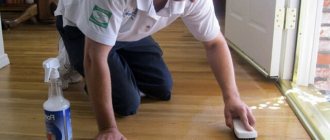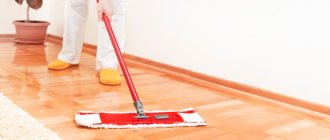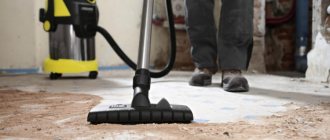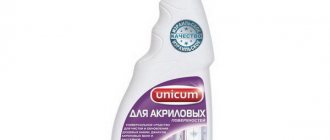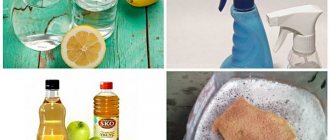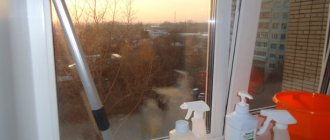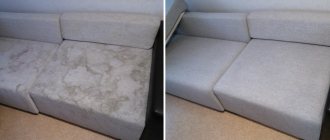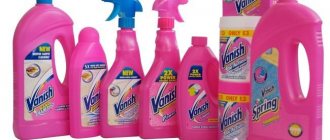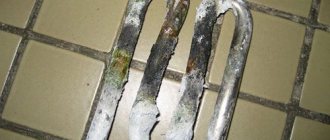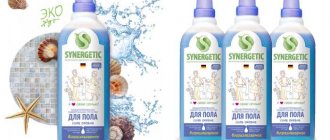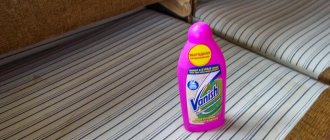Types of pollution
Contaminants may arise during repair work; they are formed due to contact with the surface:
- sealant;
- adhesive composition;
- paints;
- putties;
- primers;
- grout and other building materials.
All these substances can be easily wiped off the surface of porcelain tiles with a regular damp cloth if you start washing immediately after the substances hit the surface.
In the case of old stains, the cleaning process becomes more complicated, since not all substances are removed with water and detergents. They use specialized chemicals that cope with any type of contamination.
The coating also gets dirty for other reasons, depending on its location.
Contamination of porcelain tiles
Choice of product
Different types of contaminants are removed by different means.
| Pollution | Means |
| Rust Plaster Putty Cement Lime Wine Cigarette Stains | A product containing acid, for example for cleaning plumbing fixtures. |
| Coffee Tea Lemonade Juice Fat Tire or shoe marks | Alkaline detergents, such as dishwashing detergent or baking soda solution. |
| Mechanical and silicone oils Resin Varnish Paint Ink Marker Wax | Acetone or turpentine |
| Chewing gum | Wooden or plastic spatula |
When using acidic and alkaline products, it is recommended to dilute the products with water in a concentration of 1 part product, 5 parts water, if necessary, the concentration is gradually increased.
Before removing the stain, the product should be tested on an inconspicuous area.
Construction mixtures should be removed as soon as possible. Dried cement, plaster and putty are pre-soaked with water.
Pictured: matte Italon Landscape porcelain tiles, practical and stain-resistant.
How to clean porcelain tiles
Cleaning porcelain tiles depends on the degree of contamination.
If during the repair work the dirt was removed from the tiles immediately, then upon completion of the repair it will be enough to wash the tiles to remove any resulting dust. To do this you need:
- Clean the surface from large fractions of debris and other contaminants.
- The remaining dust on porcelain tiles is cleaned with a damp cloth soaked in any soap solution.
- To prevent streaks, the fabric used must be rinsed well in water.
- After cleaning the floor, it is recommended to rub the tiles with a dry cloth.
Important! Window sprays containing alcohol will help avoid streaks on polished tiles.
How and with what to wash primer from porcelain tiles
If porcelain tiles are stained with a primer, and unpleasant whitish stains remain, then you can clean it with household chemicals that contain acid.
Cleaning preparations for bathrooms can be available.
If stains appear again after drying, then you need to apply a bathroom cleaner, cover with a wet cloth and let it soak for an hour, then thoroughly rub the stain with a stiff brush or washcloth, then rinse with clean water and quickly wipe the stain dry.
You can easily and quickly wash the primer from porcelain stoneware using available detergents.
The ingrained, dried primer is difficult to wipe off from porcelain stoneware; it is recommended that when repairs are carried out, the following precautions are taken:
- Cover porcelain tiles with plastic film or other protective material;
- Wipe off dirt as soon as it appears, do not allow it to soak in and dry out.
- If the tile surface is unpolished or semi-polished, special protection is required.
Cleaning the joints between porcelain tiles
Sometimes you have to deal with contamination in the joints between tiles, which manifests itself in the form of mold or mildew. To remove them, use the following means:
- Specialized antifungal agent for ceramic surfaces.
- Vinegar undiluted.
- Alcohol.
- A paste of bleach and soda.
- A solution whose main component is an antifungal tablet, for example, Nystatin.
All of the above products are applied directly to the tile joints, using a toothbrush or a piece of soft cloth.
After applying these products, you must wait 1–2 hours and rinse the surface thoroughly.
Expert advice on caring for porcelain tiles
To maintain the porcelain stoneware coating in perfect condition, it is recommended to carry out the following activities:
- Wipe the floor with products containing natural or artificial wax. It is applied to the surface and rubbed thoroughly. After this treatment, the floor can be washed with plain water.
- Once a year, apply a protective layer for porcelain tiles to the floor surface.
- To make the surface shiny, add lemon juice or lemon essential oil to the washing water.
- The shine of porcelain tiles is also achieved using a water solution with vinegar.
- To polish glossy surfaces, rub the tiles with a piece of felt cloth.
- If the porcelain stoneware is rough, it is better to use a steam generator or steam vacuum cleaner to clean it, after which it is rubbed with a dry cloth. It is recommended to clean rough porcelain tiles immediately as they become dirty, then there will be no problems with cleaning them.
Advice! When using aggressive cleaning agents, they must first be tested to ensure safety and cleaning effectiveness. The test should be performed on the tile in an inconspicuous place.
When summing up, it becomes clear that it is better to wipe off any contamination immediately after it appears. But if for some reason this was not done on time, chemicals that can remove any type of stain will come to the rescue.
Source
Detergents and practical tips
How to clean the surface of wood-effect tiles
Wood-effect tiles imitate the surface of wood, repeating grooves and other “defects” of wood. To clean such a surface, you need to regularly use a floor mop, and for degreasing, solutions containing 1% buffered acid are used, such as vinegar, boron solution, and ethyl alcohol-based solutions. Degreasing is done by applying the solution with a rough cloth and vigorously rubbing the coating. After the solution has been applied, the surface is washed again and allowed to dry. The floor is then wiped using a microfiber mop.
Such solutions can also be used for daily cleaning, but more water must be used.
The most important thing in cleaning floor tiles is regular cleaning.
How to clean porcelain tiles: working methods from experts
Porcelain stoneware is an artificial finishing material that is widely used in the construction of new houses, as well as in renovations in apartments and general premises. This material is mainly used for finishing floors and walls.
It has good resistance to mechanical damage and moisture, but sometimes, especially after repairs, traces of other substances may appear on its surface. To restore the tiles to their original appearance, you should know how to clean porcelain tiles from various contaminants.
The main types and causes of contamination of porcelain stoneware
During the operation of ceramic tiles, various types of contamination may occur on its surface.
The main causes and types of pollution include:
- inaccurate cooking, leading to grease, food debris, and kitchen dirt getting on the tiles;
- there may be leaks in the bathroom, toilet, and places where the water supply pipeline is laid, which leads to strong moisture in certain areas of the tile;
- during construction and repair work, various building materials and mixtures may come into contact with the tiles - this could be plaster, gypsum, cement, sealant, grout, polyurethane foam, tile adhesive, putty, etc.;
- In places where dampness is constantly present, mold and mildew may appear on porcelain stoneware.
If contamination occurs, then the first thing that comes to mind is the question of how to wash light-colored porcelain tiles, and how to prevent stains from appearing on it during the cleaning process.
How to quickly clean porcelain tiles
There are many different ways to clean porcelain tiles quickly and without consequences for the tiles themselves.
There are both traditional methods and special chemicals that allow you to carefully clean porcelain tiles from various contaminants and protect their surface from damage.
After renovation
Basically, the question of how to clean dirt from porcelain tiles on the floor arises after renovations have been carried out in the house.
No matter how careful the craftsmen are, there will definitely be traces of various materials that need to be removed as soon as possible.
Grout
To subsequently simplify the process of cleaning tiles from grout, it is recommended to moisten the tiles with water before sealing the seams with this material. In this case, the grout can be easily removed with a wet rag or hard sponge.
If it is very ingrained and a simple sponge is not enough, then you should use acid-containing cleaning liquids and powders. These can be special household chemicals or personally prepared weak acid solutions.
Cleaning stains from porcelain tiles
To remove stains from porcelain tiles, you need to understand what substance caused the stain. For each case there is a special drug.
If stains are left by tea and coffee, as well as fruit juice, then it is best to remove them with a soda solution. Dried stains, as well as traces of wine and oil, can be easily removed with alkaline solutions or bleach.
Paint stuck to the tiles can be removed with gasoline or acetone. The same method is suitable for cleaning porcelain tiles from traces of glue and rubber.
Acid-containing preparations effectively remove stains from porcelain stoneware caused by splashes from plaster, putty and other mixtures. Before removing them, it is recommended to seal the seams between the tiles with tape to prevent the acid from damaging the grout.
With proper and careful care, porcelain tiles will last a long time, retaining all their advantages. It is enough to remember the above recommendations and apply them in practice.
Why do divorces occur?
In order to carry out quality cleaning, it is important to know the reason for the appearance of certain defects. The most pressing problem is the appearance of stains on the surface even after thorough cleaning.
Why does this happen? Let's look at the possible reasons:
- Unwashed dirt. A standard problem is when, when the tile is heavily clogged, dust particles are spread across the surface and it becomes very difficult to completely clean the tiles.
- Dirty water. During cleaning, you need to change the water as often as possible, as it contains dirt particles.
- Hard water. The problem of whitish stains and deposits is mainly associated with the high salt content in tap water.
- Unwashed product. Some cleaning products may remain on the surface of the tiles after washing them. Unless otherwise specified in the instructions, it must be washed clean.
- Dirty rag. In case of heavy contamination, it is recommended to rinse the cloth frequently under running water to remove dust particles.
Types of stains on tiles in the bathroom
Divorces can be of different types. The most common problems are:
- dirty stains;
- limescale;
- traces of detergents;
- greasy stains.
To cope with these problems, you need to select acidic media. They perfectly destroy dirt and at the same time give the tiles a glossy shine.
Cleaning joints between tiles
The tile seams are the most vulnerable spot on a tiled wall. They quickly lose color because... Dirt most often accumulates in them and mold develops. They are also unstable to some cleaning agents. For example, under the influence of hard tools and acidic detergents, the grout mixture may collapse.
- Steam cleaner. A powerful jet of steam will not only clean any type of dirt, but also get rid of fungal infections. No additional chemicals are required.
- Toothbrush. It is convenient and safe to apply cleaning compounds.
- Gel and liquid bleaches and antiseptics.
If the seams cannot be cleaned or the area of clearance is large, then the easiest way is to replace the grout. To do this, you need to arm yourself with a thin, sharp tool (such as a scraper) to clean out the damaged grout, a new mixture (preferably epoxy) and a rubber spatula. During work, the seams must be soaked with an antiseptic.
Bleaching the seams
Seams that have darkened but remain intact and not affected by mold can be bleached. For work, use household chemicals or improvised products. The most common of them:
- Marker. It is simple to use, but the effect of such an update is short-lived.
- Ready-to-use composition with a whitening component - German Mellerud, Canadian Grout. Both products are designed for cleaning grout, have properties that restore the color of grout, and remove mold and stains.
- A mixture of hydrogen peroxide and baking soda. A paste of these ingredients is rubbed into the seams with a toothbrush and left for 1-2 hours. Then the seams are thoroughly wiped.
How to clean tile gaps
It is worth noting that ceramic tiles are securely held with cement mortar on the base of the floor, and the gaps between the tiles are filled with grout. Most often, white grout is also used for white tiles. Over time, white grout fades due to dirt and turns gray. When this happens, it certainly ruins the appearance of the floor.
Cleaning the seams of floor tiles is one of the most labor-intensive processes and not the most convenient, so it is better to prevent damage to the grout
To prevent the grout from losing its color, cover it with a special solution, or periodically renew the grout.
This type of cleaning of floor tiles is only required after a period of time; if you regularly clean the floor, then the period of such work is more than six months.
Some experts recommend regrouting twice a year, but you can follow the grout manufacturer's recommendations.
Before sealing the grout, you need to clean the seam from dirt and grease; to do this, you need to mix hydrogen peroxide and water in equal proportions. Then, using a stiff brush, or an old toothbrush, apply the solution and then rinse. Only tiles can clean the seams this easily; no other material can also be cleaned; for example, this method is not suitable for laminate.
When cleaning the material, the best properties of the tiles appear, such as resistance to aggressive environments, hygienic properties and ease of cleaning. All these properties together lead to low operating costs.
Construction dust
The most harmless type of pollution, perhaps, is construction dust; its presence is inevitable when carrying out any repairs, both major and light cosmetic. After repairs, the tiles have to be washed to remove the accumulated layer of dust particles. At the same time, the question becomes relevant - how to wash the tiles and remove dirty stains without damaging its coating.
To begin with, it is recommended to sweep away the dirt with a dry cloth, and if possible, vacuum the surface. This will remove the main layer of dust and large particles that could damage the glaze. If possible, carefully scrape off any hardened finishing materials with a blade. Only after this will it be possible to begin wet cleaning to completely clean the tiled surface.
You can clean the tiles using the following means:
- Soapy water. The simplest, but very effective way. You can use washing powder.
- Water with lemon. Gives shine to a glossy surface and has a pleasant aroma.
- Vinegar. Also diluted in water. Suitable for cleaning serious stains, it also makes the surface shiny and creates a protective film.
- Glass cleaner. A simple, convenient and effective product that allows you to wash away dirt and remove stains from the surface.
Basic products for cleaning tiles from construction dust
Pollution prevention
To some extent, avoiding the unpleasant consequences of repairs in the form of the need to clean the tiles from grout and tile adhesive residues on the floor of the bathroom or kitchen, from traces of primer, paint or whitewash when finishing walls and ceilings, will help with basic steps:
- When carrying out work involving the use of wallpaper paste, primers or various types of paints, the surface of the floor or walls lined with ceramic tiles must be covered with plastic film, paper, cardboard or any other suitable material available. Otherwise, stains from these substances can add a lot of work to your work during the final cleaning of the tiles.
- When installing porcelain tiles or tiles, any remaining adhesive mixture must be immediately removed from their surface with a damp rag or sponge. Cleaning dried adhesive, especially from embossed ceramic tiles, is a labor-intensive task and, in some cases, costly, requiring the use of expensive products.
- Difficult to remove stains can also remain from traces of grout that were not removed from the tile in time. That is, the remaining grout is removed as the work on processing the seams with a fugue is completed.
Care Tips
In order for the porcelain stoneware floor or walls to remain in excellent condition for as long as possible, certain care rules must be followed:
- periodically treat the surface with wax-based compounds;
- annually use a special product designed to protect porcelain stoneware;
- to add shine, wash with lemon juice or vinegar solution;
- You can polish the glossy surface with a piece of felt cloth;
- unpolished porcelain tiles with a rough surface are cleaned using a steam generator, followed by treatment with a dry rag. It is better to clean immediately after contamination occurs.
- To ensure that there are no streaks left after washing porcelain tiles, it is enough to use glass cleaning products that contain alcohol.
To summarize, it can be noted that any contamination of porcelain stoneware is best removed without delay. But if you don’t have time, specialized products that can clean the surface of stains of any complexity will help.
Types of pollution
In order to choose a way to fix the problem, we need to figure out what we have to deal with. During renovations, many different liquids, mixtures and other chemicals are used that can literally leave a mark on your apartment for many years.
It is worth noting that such consequences are much easier to prevent in advance. This is not so difficult to do: just cover the surface with a special protective film. If you ignored this action for some reason, you simply cannot do without cleaning. Most often, in the process of finishing work, the following fall on the tiles:
- lime;
- plaster;
- grout mixture;
- silicone sealant;
- primer;
Cleaning tiles in the bathroom after renovation
- adhesive solution;
- polyurethane foam;
- dye;
- construction dust.
Naturally, they all cause damage to varying degrees, so each of them should be considered separately.
Household chemicals for cleaning tiles
Here it is also worth considering the type of surface being treated, because glossy surfaces are much easier to clean than matte and porous ones.
Cleaning the tiles
Any action must begin with preparation. In our case, this is the choice of detergent - first of all, decide what you will use for yourself - a folk method or a specially developed solution, powder or gel.
The tiles must be wiped dryFolk remedies
Despite the fact that progress has gone far ahead, many remain faithful to the good old “grandmother’s” methods. And this is not without reason. The price of these products is simply symbolic, they have been proven for decades, and the effectiveness is not inferior to the most famous advertised products. And these products are always at hand - you don’t need to go to the supermarket, choose, or spend money for them.
First, remove large debris
We have collected all the most effective ones in a table, “seasoning” them with the wonderful properties of these substances.
| Microfiber cloth + dishwashing liquid | The first element gently collects stubborn dirt, and the second element destroys the structure of fat and other dirt. |
| Bleaching powder | An ideal product for white tiles and the answer to the question “How to clean bathroom tiles?” And a plus - excellent disinfection. |
| Chalk + paper | A successful combination for cleaning glossy tiles. Chalk fights dirt, and treatment with paper after it dries gives the tiles a pristine shine. |
| Citric acid (lemon juice) | In the literal sense of the word, it corrodes grease and other dirt - it is needed by those looking for something to clean the tiles in the kitchen. |
| Vinegar | Cleaning and disinfection – two in one. |
| Ammonia | Ammonia has an unpleasant odor, but it is very effective at removing dirt and restoring shine to surfaces. |
All products are used very simply - diluted in water, after which the surface is treated with the solution.
The soap solution must be rinsed off with clean water.
Special equipment
But in some cases it is still better to give preference to special means. Let's list the most powerful and proven ones, which make it very easy to wash tiles.
“Silit” is one of the most effective remedies, the results of which are visible within a few minutes. Suitable for both wall, ceiling and floor tiles. The remedy from Amway has no claims about its effectiveness. But what makes it stand out is its high price.
Many housewives also pay attention to the active gel from this company - it can be added to other products to further activate their action. “Selena” And this remedy, on the contrary, is one of the most economical. It removes stains and grease stains perfectly. “Mr. Proper” Both a universal product and products from a special line for tiles will help. Melamine sponge Miracle sponge, which you saw in the photo, already contains an active substance - so you just need to wet it and then treat the surface with it
Many note that it is excellent at fighting stubborn fat deposits. “Mr. Muscle” A non-trivial method - but this glass cleaner will remove stains from tiles and give it shine with the same effect.
Please also pay attention to a number of products containing chlorine. This component perfectly fights traces of rust, limescale, and also disinfects tiles.
Now let's move on to the process itself.
Correct algorithm
To ensure that the tiles are in perfect condition by the end of cleaning, we advise you to follow this order in your actions:
- Use a rag, brush, or mop to remove all large debris from the surface.
- Use a dry cloth or rag to thoroughly wipe off the dust.
- Dilute one of the selected products in a bucket and treat the surface with a sponge, rag, or brush soaked in it. Physical effort may be required for cleaning to be effective.
- Rinse the tiles from the foam “coating” with clean water.
- If contaminants remain, it’s time to use a more serious remedy against them. For convenience, it can be sprayed with a spray bottle.
- Rinse the tiles clean with water again.
- Finally, use a surface shine product. It can be replaced by rubbing with paper or dry cloth.
The video in this article will clearly demonstrate these actions.
Tile Cleaning Table
| Type of tile soiling | Folk remedies for cleaning tiles | Professional tile cleaning products | Not recommended for tile maintenance |
| Traces of paint, whitewash, glue or cement, as well as stains from dirt and construction dust. | - gasoline, solvent. Acid-alkaline agents. A liter of water per 50 grams of table vinegar | KIM, Alfa-Gel. Silan | Not recommended for porcelain tiles - pastes and powders with abrasive particles. Oil based soap. Do not use hydrofluoric acid |
| Grease, mold, plaque, soot | Powder or liquid bleach; Fat dissolving agents: table vinegar and citric acid; dishwashing liquid; baking soda; ammonia; hydrogen peroxide; acetone. | Pro-Line (from 489 RUR), Megasan M (from 750 RUR). Damos chic. Citrus degreaser concentrate (Citrus Degreaser) | Do not use abrasives or scourers. |
| Heavy soiling | Water with chlorine | Rem-400 (Rem-400) – for removing heavy and stubborn dirt. | |
| Putty, lime | You can remove it with a vacuum cleaner, then polish it with a piece of wool or felt. | Alfa-Gel (from RUR 116). Super Dolphy. Silan | |
| Clean the joints between the tiles | You can use steam, chlorine with water or bleach or special products for cleaning tile joints. Toothpaste will also work, as will bleach mixed with soda. A grease solvent is also suitable, then the seams should be renewed with paint or new grout. But it's better to replace it completely. | Professional products for cleaning joints between tiles: Ultrastripper, sif, Doctor Muscle, BOZO. | |
| Lime deposits, scale, limescale, rust | Bleach solution (no more than once a month) | CMM (from 750r), Alfa-Gel (from 116r). Silan. Shrek. Super Dolphy | |
| Oil paint, ballpoint marks, metal stripes | Alcohol, acetone (minimum contact time). Mole. white spirit | Any plumbing rust remover is suitable. Kryshtal LKM. | |
| Rust, cement, concrete | Acid-based products, solvents (dangerous for joints), | Deterdek, CMM, Alfa-Gel (from 116 RUR),Schtolzer 181101 (from 262 rubles). Alpha 50. Super Dolphy | |
| Stains of resin, wax, glue, traces of tape | Gasoline, acetone | Filasolv. Citrus degreaser concentrate (Citrus Degreaser) | |
| Food, drinks, blood | Warm soda solution | DETEPTOR. Damos-shine | |
| Dirt in the recesses | You can use any product, the main thing is a brush with washing powder or soda. | Fuganet, Dolphy (from 424 rubles), Sif anti-fat. Rem-400 (Rem-400) – for removing heavy and stubborn dirt. | |
| Vegetable and machine oils, beer, coffee, wine, Coca Cola, paints, chewing gum, glue, tire marks, nicotine, urine, marker, hair dye, tape marks | Fila PS/87. Damos-shine | ||
| Coffee, wine, Coca Cola, ink, marker, nicotine, urine, hair dye. | Fila SR/95. Damos-brilliance. Spray Cleaner | ||
| Fungus, mold on tiles | Copper sulfate (per 10 liters 100 grams). Chlorine. Tea tree oil (2 tablespoons per half liter of water), pour baking soda, add table vinegar (suitable for horizontal surfaces), 10 mg. Leave the iodine on the bathroom shelf until it evaporates. borax (pour 1 cup of borax into 2.5 liters of liquid). Ingredients: 4 parts water, 2 parts hydrogen peroxide and 2 parts vinegar. Camphor balls can be placed around the bathroom. For prevention, you can use anthracene soap. | Re-grind the seams and apply an antifungal agent. Veksa (from 355 rubles), Domestos, whiteness, bleaches. Anti-mold candle from NNPTSTO company | |
| Soot, soot | Citrus degreaser concentrate (Citrus Degreaser) |
| Tile type | Tile cleaner |
| Matte tiles | Matte tiles are washed using a special emulsion, and after cleaning they are treated with protective mastic. |
| Glossy tiles | Glass cleaning liquid |
| Rough tiles | It is better to use a special mop with cut microfiber made of polyester threads. Detergents: Smart. Kiehl Corvette (from RUB 547) – capable of penetrating micropores. |
| Porcelain tiles | InterChem 502, Megalan 69. Megayut, Megalan 2. Megavin |
| Glossy tiles | D-concentrate - A powerful detergent for tiles that does not require rinsing and does not leave streaks. H.G. |
| Granite, marble | BIO GLANZ (from RUR 131) |
We suggest you read What to do after painting the floor with paint
- Do not use abrasive steel wool, as this may damage the tiles.
- When using chemicals, be sure to protect the tile joints, for example, by sealing them with construction tape.
- Any product must be rinsed with warm water after application.
- Be sure to treat glossy tiles with a water-repellent solution in the first month of use, and also wash them with acidic products in the first months to maintain shine.
- The tiles should be washed from top to bottom, avoiding streaks.
- It is necessary to clean the tiles once a week, this way you can avoid persistent stains.
Methods for cleaning ceramics from various contaminants
We will present for review an effective method for cleaning tiles from the most common types of contaminants, using both special products and cleaning methods with improvised materials and substances.
Due to the fact that the cladding of the bathroom walls occurs after the installation of ceramics on the floor, there is a danger that the primer compositions used to prepare the wall surface for finishing will come into contact with fragments of the floor covering. Wipe off stains from dried primer is a serious test of endurance and patience, so you should not allow it to get on the ceramic surface, and if this happens, then you need to remove the spills immediately using ordinary water.
Since tile is a material that is resistant to various types of adverse effects, many products are suitable for washing it
The following methods are used to clean dried primer:
- stains are dissolved with a special remover;
- the primer is washed off with acetone;
- the contamination is treated with a liquid primer;
- use of vinegar essence.
To make the dried primer easier to remove, the contaminated areas are covered with a wet rag, and some time is given to soften the dried stains.
Particularly difficult areas can be cleaned mechanically, namely using a special scraper. It is a device consisting of a handle and interchangeable blades. Pre-soaked stains are carefully removed with a scraper so as not to damage the tile; the tool must be held at an angle of 30 degrees to the surface of the tile.
Cement mortar that has not set is easily washed off with a wet sponge or rag and clean water. But you will have to tinker with the frozen solution:
- Cleaning with special removers.
- Toilet bowl cleaner works well on dried cement mortar.
- Mechanical cleaning method. Traces of the solution are removed with a metal spatula or a metal mesh for washing dishes.
We remind you that when using the mechanical method, the dried solution must first be soaked and when cleaning with metal objects, do not damage the surface of the finishing material.
After repairs, the cement should be removed from the tiles immediately before it has time to harden.
Tile adhesive
- Traditionally, the easiest way to promptly remove glue residues during the installation process is with a wet sponge.
- The frozen glue is soaked in a solution of water and vinegar or ammonia.
- Chemical treatment of contaminated areas with potent substances.
- Mechanical cleaning. Traces of glue are removed using a metal spatula, scraper, metal mesh or fine sandpaper.
Key moment. In “hopeless” cases of strongly set glue stains, it is advisable to use chemical and mechanical methods in combination.
To facilitate the process of cleaning grout from the surface of tiles in the bathroom, you must strictly follow the technology of finishing joints with fugue, do not apply too much grout to the surface to be treated and remove its excess in a timely manner.
First of all, we need to remove traces of glue as soon as possible, especially if we are dealing with ceramic tiles
Protecting glossy tiles
If the room is being renovated, the porcelain stoneware floors must be covered with protective materials. Otherwise, a dropped tool or other heavy object can split the tile and leave permanent scratches and chips on it.
It is enough to lay cardboard sheets from household appliances or, at worst, plastic film. Repairs are always accompanied by dirt and dust, so the film will protect the tiles from scratches left by particles of sand and concrete chips.
Porcelain floor tiles require protection from street dirt, which is brought into the room along with shoes. Owners of such floors should use rugs at the entrance to the house and warn guests not to walk on the tiles with boots.
If a floor lined with porcelain stoneware becomes dirty, this is not a problem for the tile itself. In this case, the tile joints suffer more, especially if they are made of cement-based grout.
The penetration of acids into these places leads to the destruction of the cement binder, resulting in a deterioration in the decorative qualities of the cladding. Therefore, during the operation of such surfaces, dirt should be removed from the tile joints in a timely manner and aggressive liquids should not be allowed to enter.
Porcelain tiles with a glossy surface are most vulnerable to damage. You need to take care of its condition immediately after finishing the facing work.
First of all, the tiles are treated with wax or other compounds that create a dirt-proof and moisture-repellent film.
This film gradually deteriorates, so treatment should be carried out once a month. In the absence of additional protection, glossy tiles will fade, become dirty and lose their former attractiveness.
Restoring its original appearance will be much more expensive and difficult compared to periodic waxing.
Glossy tiles should not be used as flooring in damp rooms or near entrance doors. This is due to the fact that the smooth polished surface becomes very slippery when water gets on it.
After renovation
How to clean tiles after renovation?
Eliminating the consequences of repairs is somewhat more difficult - especially in cases where the tile structure is porous and rough. “Harmless” construction dust is collected with a vacuum cleaner, otherwise the following approaches are used:
- It is necessary to wash off the glue “without delay”. A vinegar solution (a quarter cup per 1 liter of water) will do a wonderful job with this task; it will also rid the tiles of lime and putty. The brush should be quite stiff, but in no case metal - otherwise scratches will definitely be inevitable. Repeat rinsing several times, then dry the tiles with a soft cloth.
- The hardened liquid nails are carefully separated with a scraper (to facilitate the process, the glue is blotted several times with warm water or acetone). You can do something completely different: heat the stained area with a hair dryer and remove the solution as it melts (by the way, the same approach will eliminate frozen silicone). Due to their structure, liquid nails can withstand temperatures from -5 to +50 degrees, so instead of heating, you can successfully freeze them - the glue will crack and begin to crumble.
- Sticky traces of adhesive tape instantly disappear under the onslaught of acetone or a solvent like White Spirit.
- To wipe off fresh primer, use soapy water. Dried drops can be re-soaked with the same primer and immediately wiped dry. Of course, you shouldn’t rush with this extravagant method - first try using solvent, gasoline, glass cleaner or a special paint remover. In some cases, polishing with soda paste or vinegar essence is effective.
- If putty gets on the tile, it must be soaked with warm water and carefully scraped off with a plastic spatula. Wash the tiles with water and detergent, rinse and dry.
- Dried grout should be scraped off with a piece of wool or felt cloth. Then the tiles are washed using the same technology as in the previous case.
Tip: moisture-resistant grout mixtures can be used for minor cosmetic repairs: they perfectly mask chips and cracks on the tiles.
Of course, it’s better not to hesitate with cement-sand mortar: absorb dirt with a wet sponge as it appears. If the solution has managed to harden, you will have to do some work: first soften it with cold water (you can drop a little lemon juice), then crumble it and collect the dust with a damp cloth. Table salt also helps to remove cement from the surface of ceramics. Sprinkle the floor with dry grains, then moisten with water and leave for a few minutes. When the consistency becomes loose, remove the residue with a soft spatula or brush. Many toilet products can remove old solution. You need to soak the stains for two or even three days, periodically apply a fresh layer of the composition
Finally, wipe the tiles with a clean, damp sponge. If handled carelessly, grouts and silicone sealants can become a real headache. After drying, the substances included in their composition literally stick tightly to the tile, so soaking will also be required here
Plain water most likely will not have the desired effect; glass cleaner, pure vinegar essence, or any alcohol will do instead. Another way to remove Ceresite-type puffer is to treat the stains with diluted kerosene or a saturated solution of citric acid (half a glass of powder per 2 glasses of water). It is possible that the anti-scale agent in teapots will work.
Paint stains should be treated as soon as possible with gasoline or solvent. To wash off the composition, first use soap and then clean water. Facing damaged by liquid glass can be repaired with a weak solution of vinegar or just hot water. The stain is soaked for forty minutes (fix a wet cloth on the tile), and then cleaned off with a toothbrush. Washing off - alternately with soap and clean water - will be followed by treatment with a glass cleaner.
Tip: special paint for bathrooms helps give a “second youth” to worn-out cladding. First, the tiles are sanded and degreased with acetone (try the procedure on one inconspicuous tile); after drying, varnish is applied in two layers. If desired, you can limit yourself to a simple pattern applied with epoxy paint using a stencil.
Methods for cleaning porcelain tiles after repair
- Cement grout, plaster - easily washed off with water.
- Epoxy grout - can only be removed using a special epoxy solvent.
- Hardened glue - soaked in a solution of vinegar or premium acetone, then removed mechanically using a spatula, knife, or scraper.
- Dried paint - removed using a solvent suitable for this type of paint, first the stain is soaked, then rubbed and removed.
- Water-based paint - easily washed off with water.
- Absorbed primer is soaked with solvent or acetone, then removed mechanically.
Advice. To easily clean the tiles, you need to correctly determine the type of contamination and apply the appropriate product. However, the best way is to protect the surface before starting repair work - it can be covered with plastic film.
Primer
Now let's look at how you can clean ceramic tiles from primer after repair. White stains often remain on floor tiles, since the installation of wall cladding is carried out after it has been laid. It is advisable to spread a protective film on the floor, but this does not always provide a 100% guarantee of protection against stains.
If the primer gets on the tile, it is advisable to wash it off with clean water as quickly as possible. When the substance dries it will harden and it will be much more difficult to wash it off. For this purpose, you can use the following tools:
- special solvent-based remover;
- acetone;
- polyurethane foam;
- fresh primer.
As soon as the stain softens, you can try to clean it off. You can also use a special scraper with a sharp blade, which can be used to remove drops of frozen paint from glass surfaces.
The primer is best washed off before it hardens with clean water or solvent
Cleaning porcelain tiles with improvised means
Cleaning the floor properly after renovation is a difficult task, but if you know the methods and rules for cleaning certain types of contaminants, it can be quickly accomplished. When starting work, it is worth considering that it is much more difficult to remove dirt from a matte, porous or textured tile surface than from a glossy one. Accordingly, this will take more time.
Construction dust after renovation always settles on the tiled floor. You can remove it using any detergent, for example, for glass or dishes. First, vacuum the surface of the tile, thereby removing the top layer of dust. Then apply a cleaning solution with a soft sponge or rag, remove dirt and wipe the tiles with clean water.
If the floor is covered with granite tiles, it is better to seek the help of professionals to clean it, because... Due to the specific surface and structure, it is quite difficult to remove dirt efficiently on your own.
Putties
You can wash the tiles from traces of putty with a soap solution. Rub it over the contaminated areas, and then rinse off the residue with cold water. At the end, the floor must be wiped dry to avoid streaks.
Grouts
It is easy to clean the floor from grout immediately after completing the repair. When you have finished grouting the grout area, wet the tiles with water and wash off the dirt with a soft cloth. To clean stubborn grout, you need to purchase a special epoxy solvent that will quickly remove traces of it and not damage the surface of the tile.
Cement
If cement mortar was used to lay the tiles, excess mortar must be removed from the surface immediately after completion of the repair work. Fresh cement is quickly washed off with clean cold water.
If the cement contamination has hardened and stuck to the floor, you can only get rid of it mechanically. To do this, you will need a hard rag and a rubber spatula. First, soak the cement stains with cold water and leave for a short time. Once they are slightly soaked, carefully remove them from the floor using a spatula. It is important not to damage the tiles during the cleaning process and not to leave scratches from the tool on the surface.
If this method does not help to cope with the contamination, you can use a special professional tile cleaner. Its chemical composition is capable of dissolving cement, after which the residue is easily removed with water.
Primers
If primer gets on the tile floor during renovation, you should quickly clean it with cold water. If the stain has hardened and dried, first soften the stain with a special acetone or solvent-based remover, and then wipe with a soft sponge. If this does not help, you can remove the primer from porcelain stoneware using a special scraper with a sharp blade.
We suggest you read: How to wash sneakers from grass
Polished porcelain tiles should be washed using special formulations that do not contain powders or abrasive components. Otherwise, the glossy effect will disappear and it will have to be polished again.
In this regard, matte porcelain tiles are more unpretentious. It can be cleaned with powders without fear of the surface becoming dull or scratched. The use of abrasive cleaners on matte tiles is permitted, although not recommended.
Porcelain tile is quite resistant to the effects of aggressive chemicals, but still you should not abuse it; it is better to first try to wash it with improvised means at home.
After cutting and laying porcelain tiles, having eliminated all the resulting dirt and dust residues, it is necessary to wash them with a soapy solution. To add shine, you can wipe it again, but with clean water with the addition of ammonia, vinegar or citric acid.
How else can you clean porcelain tiles:
- Windshield cleaner - wet the stain and let it sit;
- Table salt - applied to dirt and moistened;
- Tooth powder - moistened with water and applied to the stain, then removed with a stiff brush;
- Liquid for cleaning bathrooms - applied to stains in several layers.
All these methods are quite effective and do not harm the tile surface.
